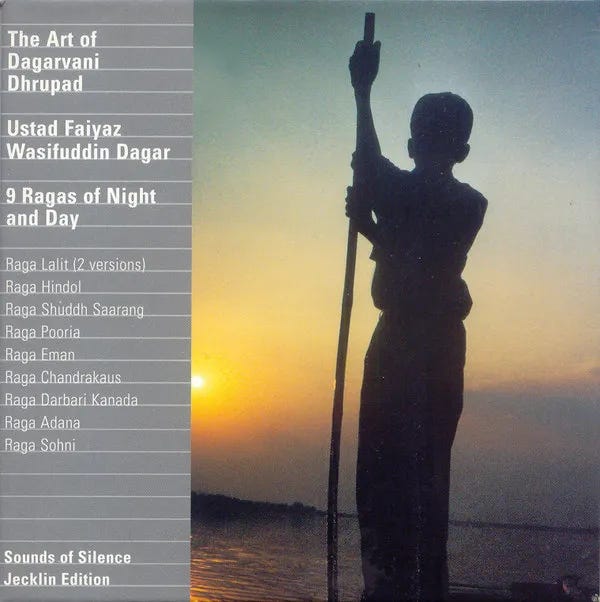Genre of the Day - Dhrupad
Album of the Day - “Raga Eman” selected from The Art of Dagarvani Dhrupad (9 Ragas of Night and Day) by Faiyaz Wasifuddin Dagar (1999)
One entertaining aspect of writing this column is the whiplash oscillation between genres from the last couple of decades like yesterday’s, with a plethora of primary-source videos and artist interviews to help me understand it by seeing the clearest picture of its roots and genres like today’s dating back thousands of years. Like its long-form compositions that stretch out to twenty, thirty, or more minutes’ time, today’s genre is one of horizons so wide I’m challenged to distill thousands of years of fine-tuning the form into a single article. It’s a welcome adventure, one through a massive ecosystem of jargon, structures, history, and particulars that make up Indian classical music’s world of both precision and pensiveness of Indian classical music.
I peered into the wide world of Indian classical music more broadly and mostly concentrated on understanding the complex detailing of ragas in my article on Hindustani Classical Music, but today we zoom in to a particular pillar of Indian musical tradition in this typically vocal form. Strangely enough, like yesterday's genre that was a portmanteau of the words hyper and fly, today’s genre combines the words dhruva-pada which together mean refrain into an uncharacteristically short name for a form of music that emphasizes lengthy composition.
Dhrupad is ultimately rooted in ancient Indian spirituality. In a primordial form of vedic chanting, it was around when the Samaveda, one of the core Sanskrit-language sacred texts laying the foundation for the Hindu religion, expounded upon the spiritual importance of music. Dhrupad has never lost that quality; it unfolds meditatively in key phases, each taking their time to properly enfold the listener into a little musical world and story. Dhrupad ragas can cover various topics, revolving around deities or epic stories and played at specific times of day.
If you get impatient at bands taking too long to sound check, either reframe it as a reflection of the angle dhrupad takes on relation between the artist and the form or avoid a dhrupad performance at all costs, I suppose. Dhrupad performances begin with the alap, a phase of the song that can last for up to an hour. The singer strives for perfection and clarity of voice as they approach the music’s build up and exploration of the subject material to come, accompanied only by sparse instrumentation and no percussion yet. Changes can be so subtle that you might have to wait minutes, an exercise in slowing down and radically appreciating waves of music at their lowest, calmest tides.
Listening to dhrupad is a profoundly intimate experience, as the concept of nada yoga influences the singer’s pursuit to understand the inner reverberations of their voice through their body. Developing this body, mind, and voice harmonic connection through singing that follows from low notes reflects the harmony of the universe and aids the singer in delivering the finest performance. The second phase consists of the slower-paced but rhythm-establishing jor where the pakhawaj drum comes in, the faster-paced jhala, and then a portion actually referred to as the dhrupad with verses that tell a story completes the cycle. The instrument of choice is typically the gorgeous rudra veena, with rich lore of its own—it was said to have been created by Shiva after contemplating the beauty of his wife Parvati, its two gourds indeed resembling an hourglass. Man Singh Tomar compiled volumes of centuries of dhrupad in the 15th century, bolstering its popularity as a form at the highest level. Khayal, a more improvisational and ‘accessible’ form of vocal classical music emerged and sidelined dhrupad a bit since the 1600s, but the number of Indian musicians gravitating towards dhrupad’s vastness and ambience has increased in recent decades.
I would be willing to be a patron of the Every Dhrupad Project delving into each dhrupad raga’s lore, so if anyone’s interested, please do reach out. But for now, I only have the time to cover one. Today, we experience the Yaman raga, a popular Carnatic (South Indian musical tradition) raga for the evening after sunset with the syllabic phase of ni-Re-Ga-/Re-Ga/ni-Re-Sa/Pa-Ma-Ga-Re/ni-Re-Sa' and in a heptatonic scale correlating to the western Lydian scale. Besides the jargon, what is it about? It is considered a grand and romantic as well as fundamental raga, taught to students early in their dhrupad journey. Despite the long runtime, I felt the music was more dynamic than it may sound abstractly on paper. The metal drone of the instrumentation is like a rich, warm bronze surrounding your ears rather than harsh, cold metal, a rich ambient background for his syllables that climb a mountain in pitch, tempo, and intensity. His vocal stabs and plucks at the very end reverberate almost like a metallic instrument and complete a fascinating exploration into a human voice’s full possibility. Once the drums come in and he’s in the verses, his voice floats amongst the ensemble as he spins a tale I dearly wish I could understand. It’s music that is thoroughly structured without feeling formulaic, beautiful without having to be lush, yet also not overly sparse, each element conveying profound, sonorous depth.
Related Genres: Hindustani Classical Music, Pansori, Konnakol





